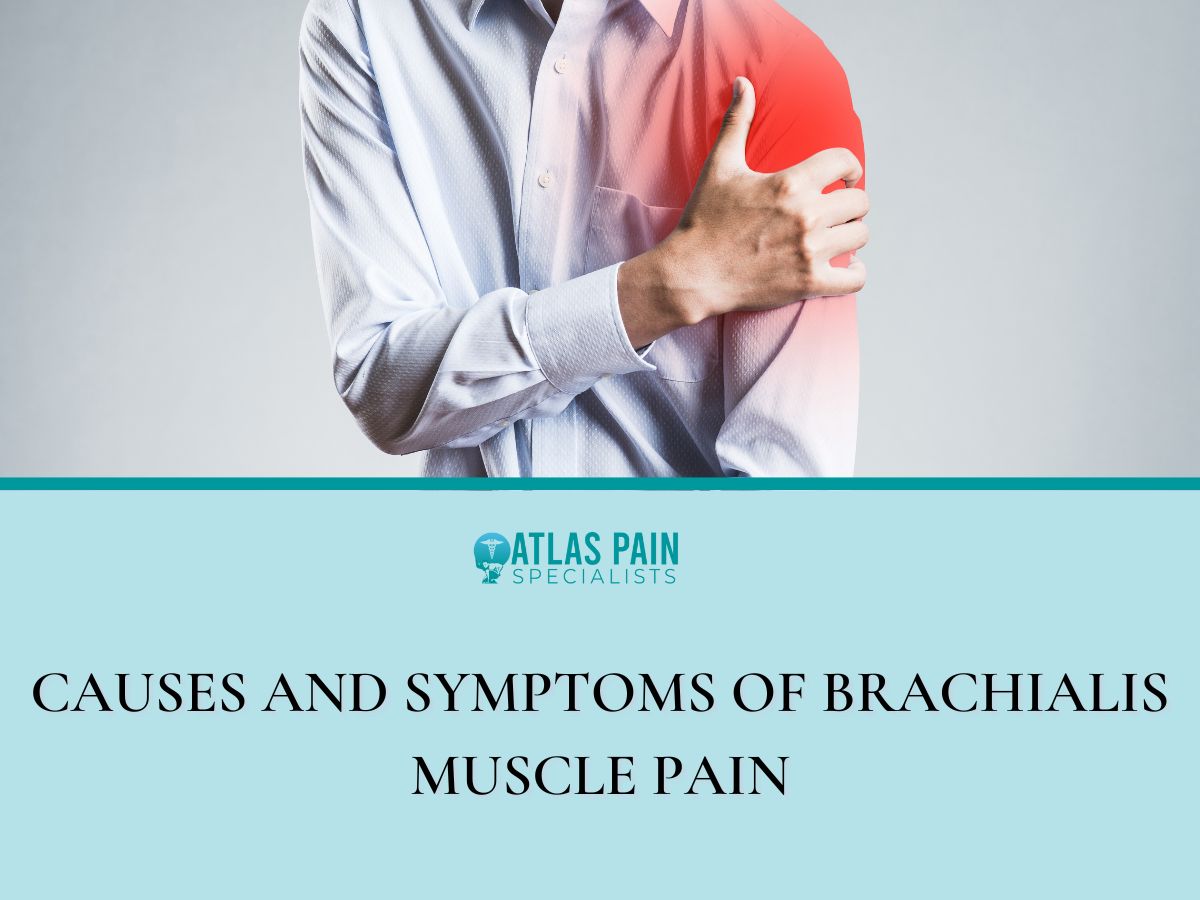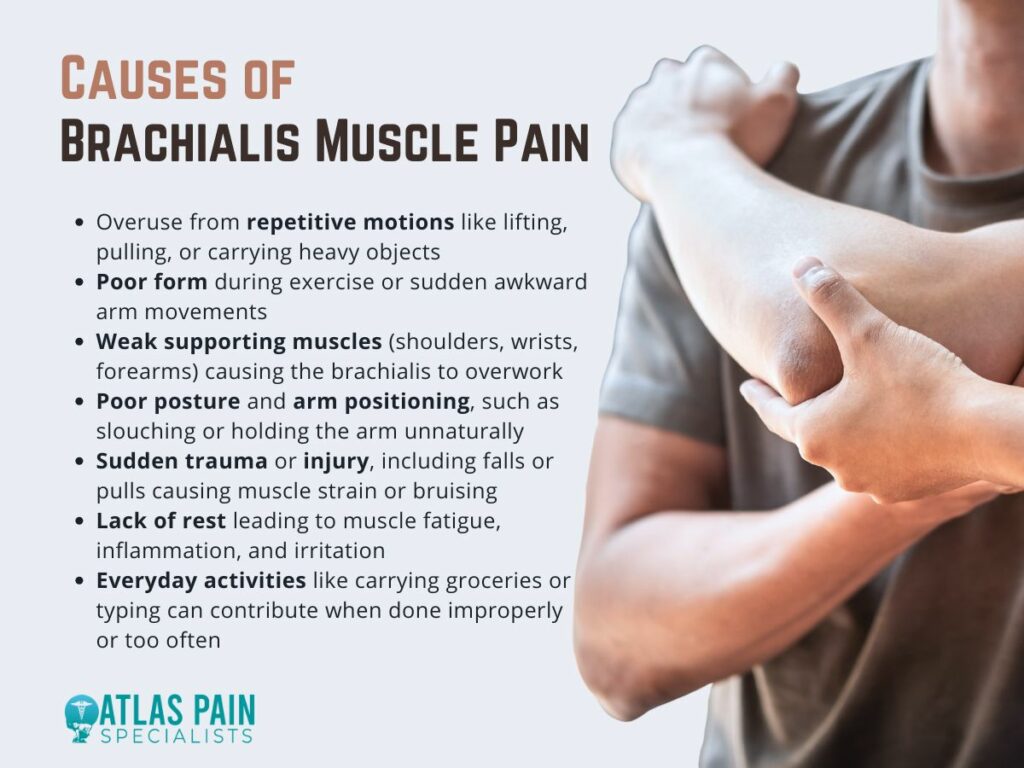

Causes and Symptoms of Brachialis Muscle Pain
A lot of people think their biceps are causing trouble when there is a deep, nagging ache in their upper arm. However, the problem might be the muscle just beneath it.
That is the brachialis, and it's used every time you pick up a grocery bag, carry your backpack, or even bend your elbow to sip your coffee when something throws it off balance like too much movement, bad form during a workout, or simply pushing through fatigue it can start to ache.
The thing with this kind of pain is it often starts slowly. One day, you're fine, and the next, a basic task like brushing your hair or pulling open a door feels uncomfortable.
The Brachialis Muscle
You may have heard of the biceps and maybe triceps when it comes to arm strength, but there’s another muscle in play. The brachialis sits deep in the front part of your upper arm.
It runs from the lower half of your upper arm bone, known as the humerus, and attaches to the top of the ulna, which is one of the bones in your forearm. This positioning connects the upper and lower parts of your arm in a very direct way.
The muscle doesn’t show much on the surface, but its structure allows it to do most of the work when you bend your elbow. It can generate a lot of force when pulling the forearm toward the shoulder.
Why the Brachialis Starts to Hurt
The brachialis is built in a way that allows it to act without depending on wrist rotation, which makes it essential in movements that involve raw pulling strength. Because it doesn’t factor in the position of your palm, it is still in use whether your hand faces up, down, or sideways.
That makes it active during more movements than you might expect. Over time, all this repeated effort adds up, especially if the muscle isn’t given enough rest or support from surrounding muscles.

- Repeating the Same Movements Too Often
Doing the same motion over and over can wear the brachialis down. You might be lifting weights, pulling heavy objects, or even working a job that requires a lot from your arms.
These repeated motions can make the muscle tired and inflamed. Even something as routine as carrying groceries or typing at a poorly positioned desk can slowly put pressure on it.
When you don’t give your arm enough time to recover, the brachialis starts to resist. It can tighten up, become sore, or feel irritated during basic movements.
- Lifting Too Much or Moving the Wrong Way
Trying to push past your limits with weights or heavy objects can overload the muscles. The brachialis is used during pulling and curling motions, so lifting without proper form can cause it to strain.
You might not feel the pain right away, but soreness can show up hours later and stick around longer than expected. Moving the wrong way, twisting your arm awkwardly, or yanking something without preparation can also cause sudden stress.
These quick, careless motions are often the start of a sharp, constant pain that won’t go away on its own.
- Weak Supporting Muscles Around the Arm
When nearby muscles don’t do their part, the brachialis ends up doing too much. Weak shoulders, tight forearms, or unstable wrists can force it to overcompensate.
This extra effort wears it out faster and makes it more likely to become irritated. Without balance in the arm, even small tasks can feel harder on this one muscle.
Improving strength in the rest of your upper body can take pressure off the brachialis and help it work without stress.
- Poor Posture and Arm Positioning
Your posture affects your arms more than you’d expect. Slouching, hunching over a desk, or holding your phone at an awkward angle for long periods can lead to poor arm alignment.
That kind of positioning can stretch or compress the brachialis in unnatural ways. Even small changes in how you sit, work, or carry things can make a difference.
Keeping your arm in a more natural position allows the muscle to move freely, which helps reduce unnecessary tension over time.
- Sudden Injury or Trauma
A fall, collision, or even a bad pull can shock the muscle. These moments might seem minor at first, but the brachialis can bruise, tear slightly, or become inflamed from one wrong move.
Pain from this kind of injury usually comes on quickly and feels sharper or deeper than soreness from overuse. Letting the muscle heal fully before going back to normal activity can help avoid making things worse.
Rushing back into movement without care can turn a minor issue into a longer recovery.
What Brachialis Pain Feels Like
Pain in your arm sometimes feels vague, or overlaps with other muscles, making it tough to pinpoint exactly where it's coming from. When the brachialis is involved, the discomfort often feels deep and tucked under the surface, almost like something is pulling inside your arm rather than on top of it.
You may notice it most when your arm is in motion, especially when you bend the elbow or carry something heavy.
- A Deep Ache That Doesn’t Quite Feel Like the Biceps
Brachialis pain tends to sit low in the upper arm, close to the elbow, and not directly in the center like typical biceps soreness. It can feel like a tight or aching sensation that rests just beneath the biceps, making it harder to identify right away.
You might notice it during elbow flexion or when picking up items, even if they aren’t that heavy. Because this muscle isn’t on the surface, the pain often feels buried.
It may seem like it comes from the joint or even the bone, but it’s actually the brachialis.
- Sharp Discomfort With Simple Elbow Movements
You might feel a sharper kind of pain when you bend your elbow under pressure. Lifting weights, pulling something toward you, or even opening a tight jar can trigger it.
This sharpness usually fades with rest but returns during the next effort. It’s the kind of sensation that makes you hesitate mid-movement, not because the object is too heavy, but because the muscle sends a quick warning.
This warning can become more regular and harder to ignore.
- Soreness or Tenderness When You Press the Area
Running your fingers along the inside of your upper arm, especially near the elbow, might reveal a spot that feels unusually tender. It’s not the same as general arm soreness.
The tenderness is often focused and can be uncomfortable even with light pressure. This spot can feel like a bruise or a knot, depending on how much the muscle has been overworked or strained.
Pressing it may even recreate the pain you feel during movement, which helps confirm that the brachialis is likely involved.
- Weakness and Tightness That Comes Out of Nowhere
When carrying stuff or doing curls at the gym your arm might feel weaker than usual. That sense of weakness isn’t always pronounced, but it can be frustrating.
It feels like your arm just doesn’t want to work as hard as it used to. Along with that weakness, there might be a tight sensation that limits how far you can extend or bend your elbow.
It may feel like your range of motion shrunk slightly without a clear reason. These signs often appear together, especially in the early stages of brachialis strain.
When to Seek Help
Not all muscle pain needs medical attention. Most of the time, a little rest, a warm compress, or some light stretching can settle things down.
But there are moments when pain isn’t just a passing issue. It keeps coming back, grows worse, or starts to affect how you live your day. That’s when you should stop guessing and consider getting help.
- When Rest Doesn’t Seem to Help
Taking a break should usually ease a sore muscle, especially if overuse or a minor strain causes discomfort. But if you’ve given your arm time off, avoided heavy lifting, and skipped workouts, yet the pain still lingers, it may point to something deeper.
A muscle that doesn’t respond to rest may be dealing with a more serious strain or a small tear. Pain that sticks around longer than a week or feels just as sharp every time you return to movement could be a sign that recovery isn’t happening as it should.
A trained specialist can help figure out what’s actually going on.
- When the Pain Gets Worse Over Time
What starts as a light ache shouldn’t gradually turn into stabbing pain. If things feel more painful after just a few days, even without much activity, that’s not something to ignore.
Muscles that get worse instead of better are usually irritated beyond the point of simple soreness. Increased pain during basic movements like brushing your teeth or pouring a drink is a sign that the muscle isn’t healing on its own.
The longer it’s left untreated, the more inflamed or damaged it can become.
- When You Notice Swelling, Numbness, or Bruising
Swelling or a visible change in the shape of your arm may suggest more than a basic strain. The brachialis doesn't usually swell unless a significant pull or tear is experienced.
If your skin feels tight or looks puffy in the area near the elbow or upper forearm, that’s your cue to slow down and speak to a medical provider. Numbness or tingling is also worth your attention.
These sensations often point to nerve involvement, which means more than just muscle tissue is affected. Bruising, especially if it appears suddenly, can signal internal bleeding or a tear that needs evaluation.
- When Movement Feels Limited or Impossible
A muscle that refuses to stretch or contract fully might be stuck in a protective response due to injury. When your elbow feels stiff, or you can’t fully bend or extend your arm without pain, your body is likely guarding against more damage.
In that case, forcing movement only makes things worse. Instead of pushing through it, let a professional take a look. A physical therapist or sports doctor can help guide your recovery with the right plan, so the muscle heals properly and your range of motion returns.
Understanding Radiohumeral Bursitis
When pain takes over part of your arm, especially near the elbow, it can be hard to tell where it's truly coming from. One area aches, another feels tight, and before long, you're guessing which muscle or joint is to blame.
There's also another piece to this puzzle: the small fluid-filled sac called the radiohumeral bursa. It sits near the elbow joint, right where the radius bone meets the humerus.
When this bursa becomes inflamed, a condition called radiohumeral bursitis can develop, and its symptoms often overlap with brachialis pain. You might feel soreness near the elbow, experience stiffness when trying to extend your arm, or even confuse the two issues entirely.
About Dr. Sean Ormond



